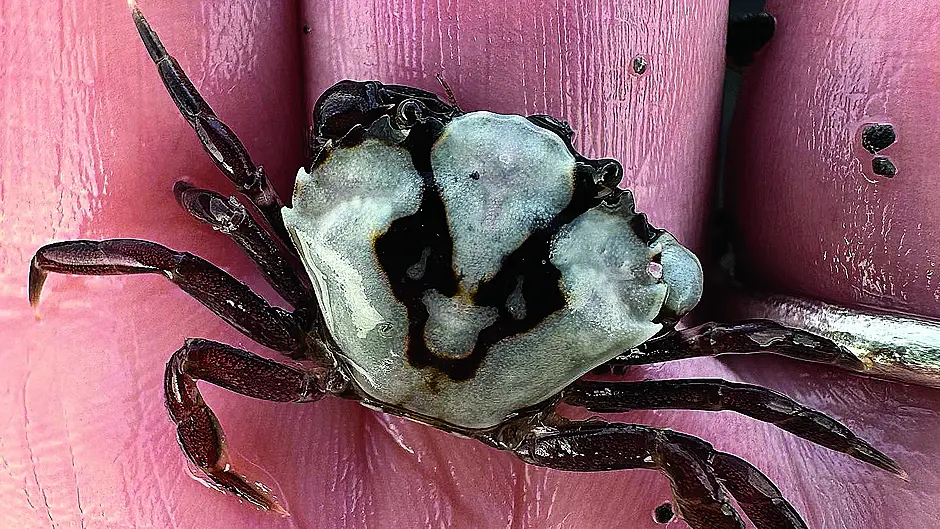WEST Cork is home to many animals that are masters of disguise.

Some mimic other species to avoid predators, while others blend seamlessly into their surroundings.
Camouflage takes many forms, from simple colour changes to intricate mimicry.
While chameleons are most often associated with this skill, many species local to West Cork have evolved clever tactics to remain hidden in plain sight.
Understanding these disguises will help you spot them more easily.
Background matching
Camouflage is a crucial defence mechanism that helps animals to avoid detection by predators, while also allowing predators to remain hidden from prey until the perfect moment to strike.
Camouflage can include background matching, disruptive colouration, countershading, disguise and mimicry.
The simplest form is background matching, where an animal’s colour or pattern mirrors their surroundings.
For example, green shieldbugs blend into leaves while feeding, and the speckled pattern of brown trout helps them disappear against gravelly riverbeds.
Countershading
Have you ever noticed that many animals are darker on top and lighter underneath? This is known as countershading.
Because natural light comes from above, this shading helps balance shadows and light, making animals less visible.
Species like the Irish stoat, Irish hare and common lizard use countershading to stay hidden in their environments.
This adaptation is especially evident in marine animals, such as herring, mackerel and dolphins.
Viewed from above, their darker upper surfaces blend with the ocean depths. From below, their lighter underbellies merge with light filtering down from the surface.
Startled by snipe
For mobile species or those moving through varied habitats, disruptive patterns can be particularly effective.
Bold markings create visual ‘noise’ that breaks up the animal’s outline, making it harder to distinguish where the body begins or ends.
This is common in birds, which often have feathers that match their environment combined with patterns that divert attention from their overall shape.
The common snipe is a prime example. They rest in marshy vegetation and remain undetected until they take flight, often startling walkers.
Their heads and bodies are marked with dark brown, pale buff and black stripes and bars, helping to blend into the surrounding area.
Animals also use irregular outlines to blur the distinction between their bodies and the environment, making them harder to spot.
Moth or a twig?
The caterpillars of some moth species, especially geometrids, use a tactic called masquerade, disguising themselves as twigs or plant stems. When disturbed, they even sway to mimic vegetation moving in the wind.
The peppered moth is one species I often encounter while recording moths in West Cork, though I’ve never spotted their caterpillars.
These caterpillars mimic both the form and colour of twigs.
Research shows they can sense the colour of a twig through their skin, adjusting their own tone to match. When given a choice of resting places, they select twigs that best match their colour.
Mimicking twigs isn’t exclusive to caterpillars—adult moths use this ploy too. The buff-tip moth, for instance, looks like a broken stick, while some moths even resemble bird droppings to avoid detection.
Crafty strategies
Some species attach materials to their bodies for camouflage.
Recently, I spotted what looked like a tiny ball of fluff moving across a leaf.
This curious sight turned out to be a lacewing larva.
Lacewings are flying insects and their larvae feed on small insects such as aphids. Once they have fed on an aphid, some lacewing species use the dried out remains to remain hidden, sticking the left-over skins to their own backs.
Another species to look out for is the flower crab spider.
Commonly found on flowers from May to August, they sit in wait for visiting pollinators.
Amazingly, they change colour to match the flower they’re on. Unsuspecting bees, flies and wasps often receive an unpleasant surprise when the alight to feed.
Marine magic
Octopuses, cuttlefish and squid are among the best and fastest at camouflage. They can change their colour, body shape and skin texture to suit their background within seconds.
Closer to shore, you can witness marine camouflage in action yourself. Green shore crabs are common all along our coastline. Although named ‘green’, juvenile shore crabs are remarkable in that they can vary their colouring and patterns to match their environment.
As they grow older and become more mobile, they typically adopt that more uniform green colour, providing camouflage on rocky shores and seabeds further out.
Like peppered moth caterpillars, these crabs seem to know what they look like. In studies, when given a choice, they move to environments where their shell colours most closely match.
These juvenile crabs can change the shade of their shells within hours, becoming lighter on a white background and darker on a black one due to actions of pigment containing cells known as chromatophores.
Spotting a well-camouflaged animal can be challenging but the hunt for hidden creatures is an enjoyable pursuit. See if you can spot any of West Cork’s elusive wildlife on your next walk!







